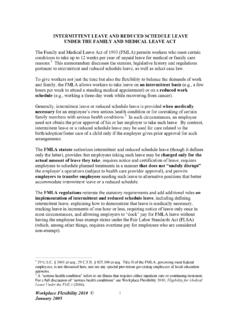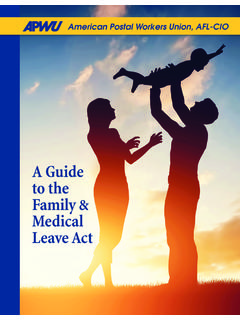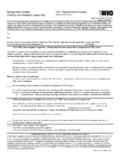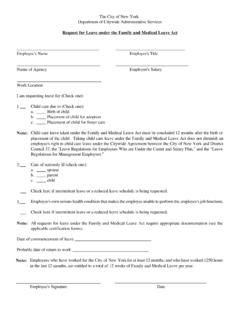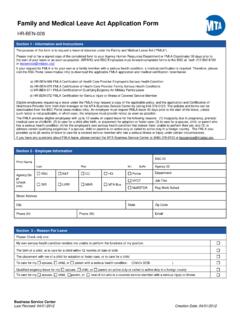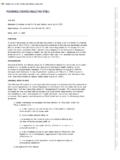Transcription of Fact Sheet #28: The Family and Medical Leave Act …
1 Department of Labor Employment Standards Administration Wage and Hour Division (November 2007) Fact Sheet #28: The Family and Medical Leave Act of 1993 THE Family AND Medical Leave ACT OF 1993 ered by the law and re subject to the jurisdiction of the Office of Personnel Management or the Congress. ) ve Leave or fiscal year, or a 12-month period prior to or after the commencement of Leave as e 12-month period. e on for employees who request or take FMLA Leave . The law also requires mployers to keep certain records. MPLOYER COVERAGE MLA applies to all: t y or activity affecting commerce including joint employers and successors of covered employers. MPLOYEE ELIGIBILITY To be eligible for FMLA benefits, an employee must: 4.
2 N of the United States where at least 50 employees are employed by the employer within 75 miles. See special rules for returning reservists under USERRA The Department of Labor's Employment Standards Administration, Wage and Hour Division, administers and enforces the Family and Medical Leave Act (FMLA) for all private, state and local government employees, and some federal employees. Most Federal and certain congressional employees are also cova FMLA became effective on August 5, 1993, for most employers. If a collective bargaining agreement (CBAwas in effect on that date, FMLA became effective on the expiration date of the CBA or February 5, 1994, whichever was earlier. FMLA entitles eligible employees to take up to 12 weeks of unpaid, job-protected leain a 12-month period for specified Family and Medical reasons. The employer may elect to use the calendar year, a fixed 12-monthth The law contains provisions on employer coverage; employee eligibility for the law's benefits; entitlement to Leave , maintenance of health benefits during Leave , and job restoration after Leave ; notice and certification of thneed for FMLA Leave ; and, protectie E F public agencies, including state, local and federal employers, local education agencies (schools), and private-sector employers who employed 50 or more employees in 20 or more workweeks in the currenor preceding calendar year and who and engaged in commerce or in any industr E 1.)
3 Work for a covered employer; 2. have worked for the employer for a total of 12 months*; 3. have worked at least 1,250 hours over the previous 12 months*; and work at a location in the United States or in any territory or possessio*. Leave ENTITLEMENT total of 12 workweeks of unpaid Leave during any 2-month period for one or more of the following reasons: to take Medical Leave when the employee is unable to work because of a serious health condition. , for placement of a child for adoption or foster care, and to care r a parent who has a serious health condition. and care, or placement for adoption or foster care must conclude within 12 months of the birth r placement. which means taking Leave in locks of time, or by reducing their normal weekly or daily work schedule. r placement for adoption or foster care, use of intermittent Leave is re for a seriously ill Family member, or because the employee is seriously ill and unable to work.
4 May choose to use accrued paid Leave (such as sick r vacation Leave ) to cover some or all of the FMLA Leave . esignating if an employee's use of paid Leave counts as FMLA Leave , based on formation from the employee. s health condition" means an illness, injury, impairment, or physical or mental condition that involves ither: tal, ty, and any period of incapacity or subsequent treatment in iod of incapacity ( , inability to work, attend school or perform other regular daily activities) due to: three equent treatment or period of incapacity relating to the same condition, that also includes: one treatment by a health care provider with a continuing regimen of treatment; or regnancy or prenatal care. A visit to the health care provider is not necessary for each absence; or A covered employer must grant an eligible employee up to a1 for the birth and care of the newborn child of the employee; for placement with the employee of a son or daughter for adoption or foster care; to care for an immediate Family member (spouse, child, or parent) with a serious health condition; or Spouses employed by the same employer are jointly entitled to a combined total of 12 work-weeks of Family Leave for the birth and care of the newborn childfo Leave for birtho Under some circumstances, employees may take FMLA Leave intermittentlybIf FMLA Leave is for birth and care osubject to the employer's approval.
5 FMLA Leave may be taken intermittently whenever medically necessary to ca Also, subject to certain conditions, employees or employers o The employer is responsible for din "Serioueany period of incapacity or treatment connected with inpatient care ( , an overnight stay) in a hospihospice, or residential Medical -care faciliconnection with such inpatient care; or Continuing treatment by a health care provider which includes any per(1) A health condition (including treatment therefor, or recovery therefrom) lasting more thanconsecutive days, and any subs treatment two or more times by or under the supervision of a health care provider; or(2) P(3) A chronic serious health condition which continues over an extended period of time, requires periodic visits to a health care provider, and may involve occasional episodes of incapacity ( , asthma, diabetes). A visit to a health care provider is not necessary for each absence; or (4) A permanent or long-term condition for which treatment may not be effective ( , Alzheimer's, a severe stroke, terminal cancer).
6 Only supervision by a health care provider is required, rather than active treatment; or (5) Any absences to receive multiple treatments for restorative surgery or for a condition which would likely result in a period of incapacity of more than three days if not treated ( , chemotherapy or radiation treatments for cancer). "Health care provider" means: doctors of medicine or osteopathy authorized to practice medicine or surgery by the state in which the doctors practice; or podiatrists, dentists, clinical psychologists, optometrists and chiropractors (limited to manual manipulation of the spine to correct a subluxation as demonstrated by X-ray to exist) authorized to practice, and performing within the scope of their practice, under state law; or nurse practitioners, nurse-midwives and clinical social workers authorized to practice, and performing within the scope of their practice, as defined under state law; or Christian Science practitioners listed with the First Church of Christ, Scientist in Boston, Massachusetts; or Any health care provider recognized by the employer or the employer's group health plan benefits manager.
7 MAINTENANCE OF HEALTH BENEFITS A covered employer is required to maintain group health insurance coverage for an employee on FMLA Leave whenever such insurance was provided before the Leave was taken and on the same terms as if the employee had continued to work. If applicable, arrangements will need to be made for employees to pay their share of health insurance premiums while on Leave . In some instances, the employer may recover premiums it paid to maintain health coverage for an employee who fails to return to work from FMLA Leave . JOB RESTORATION Upon return from FMLA Leave , an employee must be restored to the employee's original job, or to an equivalent job with equivalent pay, benefits, and other terms and conditions of employment. In addition, an employee's use of FMLA Leave cannot result in the loss of any employment benefit that the employee earned or was entitled to before using FMLA Leave , nor be counted against the employee under a "no fault" attendance policy.
8 Under specified and limited circumstances where restoration to employment will cause substantial and grievous economic injury to its operations, an employer may refuse to reinstate certain highly-paid "key" employees after using FMLA Leave during which health coverage was maintained. In order to do so, the employer must: notify the employee of his/her status as a "key" employee in response to the employee's notice of intent to take FMLA Leave ; notify the employee as soon as the employer decides it will deny job restoration, and explain the reasons for this decision; offer the employee a reasonable opportunity to return to work from FMLA Leave after giving this notice; and make a final determination as to whether reinstatement will be denied at the end of the Leave period if the employee then requests restoration. A "key" employee is a salaried "eligible" employee who is among the highest paid ten percent of employees within 75 miles of the work site.
9 NOTICE AND CERTIFICATION Employees seeking to use FMLA Leave are required to provide 30-day advance notice of the need to take FMLA Leave when the need is foreseeable and such notice is practicable. Employers may also require employees to provide: Medical certification supporting the need for Leave due to a serious health condition affecting the employee or an immediate Family member; second or third Medical opinions (at the employer's expense) and periodic recertification; and periodic reports during FMLA Leave regarding the employee's status and intent to return to work. When intermittent Leave is needed to care for an immediate Family member or the employee's own illness, and is for planned Medical treatment, the employee must try to schedule treatment so as not to unduly disrupt the employer's operation. Covered employers must post a notice approved by the Secretary of Labor explaining rights and responsibilities under FMLA.
10 An employer that willfully violates this posting requirement may be subject to a fine of up to $100 for each separate offense. Also, covered employers must inform employees of their rights and responsibilities under FMLA, including giving specific written information on what is required of the employee and what might happen in certain circumstances, such as if the employee fails to return to work after FMLA Leave . UNLAWFUL ACTS It is unlawful for any employer to interfere with, restrain, or deny the exercise of any right provided by FMLA. It is also unlawful for an employer to discharge or discriminate against any individual for opposing any practice, or because of involvement in any proceeding, related to FMLA. ENFORCEMENT The Wage and Hour Division investigates complaints. If violations cannot be satisfactorily resolved, the Department of Labor may bring action in court to compel compliance.
